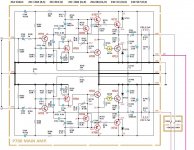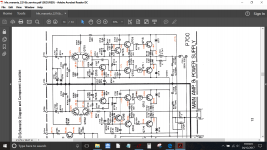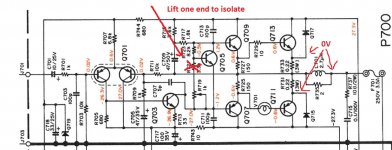Hi All, I have bin working on rebuilding this unit, i guess there is a correct way to start and not, when i got this unit one channel was out, i guess i should have asked where to start looking to trouble shoot, I did not and started recapping all the boards. They are done my next move is to change out the transistors, but before i take on that challenge, were does one start to troubleshoot when one channel is out???
Pat
Pat
You start by gathering as much evidence as you can in the form of basic voltage checks and a physical examination of the unit. All the clues will be there.
Changing caps in hope, and particularly swapping semiconductors is I'm afraid a recipe for disaster. You need to first find and repair the existing fault and only then begin to think of replacing any other parts that may be suspect due to age and perhaps being in a high temperature location on the board.
Changing caps in hope, and particularly swapping semiconductors is I'm afraid a recipe for disaster. You need to first find and repair the existing fault and only then begin to think of replacing any other parts that may be suspect due to age and perhaps being in a high temperature location on the board.
Hey Pat, head over to Audiokarma and search for Marantz sub-forum. If it's anything like the Pioneer forum, you should find lots of usefull info. Marantz Audio | Audiokarma Home Audio Stereo Discussion Forums
jeff
jeff
Last edited:
Hi Mooly,and thanks for the feed back, i guess being a newbie there is a learning curve since i did things backwards is there still hope in finding the fault???
Pat
There is always hope
Service manual is here:
Marantz 2216 - Manual - Stereophonic Receiver - HiFi Engine
Your first step would be to do a quick confirmation of the DC voltages on the output transistors H711, 112, 113 and 114, in particular that the marked 23 volts is somewhere in that ballpark and not very high or very low.
Attachments
....were does one start to troubleshoot when one channel is out???
One technique is to compare the "good" and "bad" channels. Voltage etc. Part condition.
This works good in some circuits. This type direct-coupled amplifier can be a brain-pain, because any fault tends to show-up everywhere. Some electric basics helps a lot.
Help Marantz 2216B
Hi All, I am having a problem,I cleaned all the pots and switches, recapped this unit changed a blown fuse, changed out the transistors except a couple that i am still waiting for ( China go figure) 2SC 1384 and 2SC684, yet i get a serge on the left channel the V701 goes from off to a very high glow when the volume is turned down all by it self. It acts like a built in DBT, I did the bias that is fine i am at a lost any help would really be appreciated
Pat
Hi All, I am having a problem,I cleaned all the pots and switches, recapped this unit changed a blown fuse, changed out the transistors except a couple that i am still waiting for ( China go figure) 2SC 1384 and 2SC684, yet i get a serge on the left channel the V701 goes from off to a very high glow when the volume is turned down all by it self. It acts like a built in DBT, I did the bias that is fine i am at a lost any help would really be appreciated
Pat
Looks like it is different. This one has a differential input stage and also runs on dual or split supplies.
Same fault finding rules apply although now you are making sure that the voltage on the output (L701 and L702) is close to zero volts DC.
If one channel is dead then be sure to check the speaker fuse.
Same fault finding rules apply although now you are making sure that the voltage on the output (L701 and L702) is close to zero volts DC.
If one channel is dead then be sure to check the speaker fuse.
Attachments
Here is my new post I am having a problem,I cleaned all the pots and switches, recapped this unit changed a blown fuse, changed out the transistors except a couple that i am still waiting for ( China go figure) 2SC 1384 and 2SC684, yet i get a serge on the left channel the V701 goes from off to a very high glow when the volume is turned down all by it self. It acts like a built in DBT, I did the bias that is fine i am at a lost any help would really be appreciated
Pat
Pat
I don't know how you are working on this but here is what I would do.
1/ Use a bulb tester initially. It can save a lot of grief.
2/ Turn the bias down as low as it will go. That means turning R719 to maximum resistance but even better would be to lift one end of R721 (3.3k). That will force a minimum bias condition.
3/ Now measure the basic DC conditions. That means checking the power supply voltages are correct (they will be a little low with a bulb tester).
Check the voltage on L701. It should be zero.
Many of the marked voltages are grossly in error (unfortunately typical of many manuals).
That should be enough to be going on with.
And NO speakers attached for any of this, and volume on minimum with no signal applied.
1/ Use a bulb tester initially. It can save a lot of grief.
2/ Turn the bias down as low as it will go. That means turning R719 to maximum resistance but even better would be to lift one end of R721 (3.3k). That will force a minimum bias condition.
3/ Now measure the basic DC conditions. That means checking the power supply voltages are correct (they will be a little low with a bulb tester).
Check the voltage on L701. It should be zero.
Many of the marked voltages are grossly in error (unfortunately typical of many manuals).
That should be enough to be going on with.
And NO speakers attached for any of this, and volume on minimum with no signal applied.
- Status
- This old topic is closed. If you want to reopen this topic, contact a moderator using the "Report Post" button.
- Home
- Amplifiers
- Solid State
- Marantz 2216B rebuild


 sounds like a plan.
sounds like a plan.